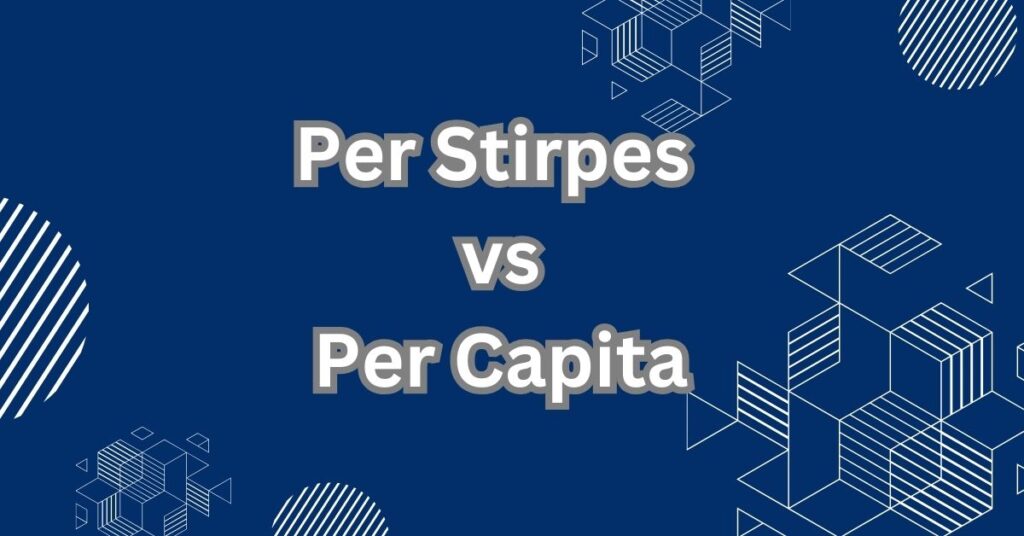Ever wondered what would happen if your carefully laid estate plans went sideways? You’re not alone. Let’s dive into the fascinating world of per stirpes vs per capita – two terms that could make or break your legacy.
You’ve just finished writing your will, feeling pretty good about yourself. But have you considered what might happen if one of your beneficiaries kicks the bucket before you do? That’s where per stirpes vs per capita come into play, and trust me, they’re not just fancy Latin phrases to impress your friends at dinner parties.
Understanding these concepts is crucial because they determine how your assets are distributed when things don’t go according to plan. It’s like choosing between a branching river and a shared pool – and the wrong choice could leave some of your loved ones high and dry.
Table of Contents
Estate Planning
Before we dive into the nitty-gritty, let’s get our bearings. Estate planning is all about deciding who gets what when you’re gone. It’s like playing Monopoly, but with real-life consequences. You’ve got your assets (properties, cash, that vintage comic book collection), and you need to decide how to divvy them up.
When Beneficiaries Die Before the Testator
Here’s where it gets interesting. What happens if one of your beneficiaries checks out before you do? This is where per stirpes and per capita come in, acting like a GPS for your assets, redirecting them when the original route is blocked.
Per Stirpes

What’s Per Stirpes?
Per stirpes, Latin for “by branch,” is like a family tree for your inheritance. If a beneficiary dies before you, their share trickles down to their descendants. It’s the estate planning equivalent of “keeping it in the family.”
Real-life Example: The Johnson Family Saga
Let’s meet the Johnsons:
- Grandma Johnson has two children: Sarah and Tom
- Sarah has two kids: Alex and Emily
- Tom has one child: Jack
Grandma Johnson’s will leaves her estate to her children per stirpes. But tragedy strikes, and Sarah dies before Grandma. Here’s how it plays out:
- Tom gets 50% of the estate
- Sarah’s 50% is split between her children: Alex gets 25%, and Emily gets 25%
- Jack, Tom’s child, doesn’t get anything extra
Pros and Cons
Pros:
- Keeps inheritance within family branches
- Protects grandchildren’s inheritance if a parent dies
- Maintains the testator’s original intent
Cons:
- Can lead to unequal distribution among grandchildren
- Might not account for changing family dynamics
- Can be confusing for large, complex families
Per Capita

Decoding Per Capita Distribution
Per capita, meaning “by head,” is the democratic cousin of per stirpes. It’s all about equal shares among surviving beneficiaries. If a beneficiary dies, their share is redistributed equally among the remaining beneficiaries.
Story Time: The Smiths’ Surprising Inheritance
Meet the Smiths:
- Grandpa Smith has three children: John, Mary, and Peter
- Each child has two kids of their own
Grandpa Smith’s will leaves his estate to his children per capita. But John passes away before Grandpa. Here’s the twist:
- Mary gets 50% of the estate
- Peter gets 50% of the estate
- John’s children? They’re out of luck
The Good, the Bad, and the Ugly of Per Capita
The Good:
- Simple and straightforward
- Ensures equal distribution among surviving beneficiaries
- Can prevent family disputes over unequal shares
The Bad:
- Might unintentionally disinherit grandchildren
- Doesn’t account for family size differences
- Can lead to hurt feelings if a deceased beneficiary’s family is left out
The Ugly:
- Potential for manipulation (e.g., pressuring elderly beneficiaries)
- Can cause resentment between family branches
- Might not align with the testator’s true wishes
Per Stirpes vs Per Capita
Key Differences That’ll Make Your Head Spin
| Aspect | Per Stirpes | Per Capita |
| Distribution Method | By family branch | Equally among survivors |
| Treatment of Deceased Beneficiary’s Share | Passes to their descendants | Redistributed among survivors |
| Complexity | More complex | Simpler |
| Flexibility | Accounts for family structure | Treats all beneficiaries equally |
| Potential for Disinheritance | Lower | Higher |
Which One’s Right for You?
Choosing between per stirpes and per capita is like picking between a Swiss Army knife and a sledgehammer. One’s more versatile, the other’s more straightforward. Your choice depends on:
- Your family structure
- Your relationships with potential beneficiaries
- Your desire for equality vs. family branch preservation
- The complexity you’re willing to deal with
Common Misconceptions:
“Per Stirpes Always Favors Grandchildren” – Oh, Really?
False! Per stirpes doesn’t automatically benefit grandchildren. It only comes into play if their parent (your child) dies before you. In some cases, it can actually lead to unequal distribution among grandchildren.
“Per Capita is Always Fairer” – Think Again!
Not necessarily. While per capita ensures equal distribution among survivors, it can unintentionally disinherit entire branches of the family. Fair? That’s in the eye of the beholder.
Debunking Other Myths
- Myth: Per stirpes is always more complicated.
- Reality: For some family structures, it can actually be simpler.
- Myth: Per capita always results in smaller individual shares.
- Reality: It depends on the number of surviving beneficiaries.
- Myth: You can’t combine per stirpes and per capita.
- Reality: You can, but it requires careful planning and clear language.
Legal Landscape: USA vs UK
How Per Stirpes and Per Capita Play Out Across the Pond
Both the USA and UK recognize per stirpes and per capita distribution, but there are some key differences:
USA:
- Terms are widely used and recognized in legal documents
- State laws may vary in their default interpretations
- More flexibility in combining distribution methods
UK:
- Terms are used, but “by representation” is more common than “per stirpes”
- Inheritance Tax considerations play a larger role
- Stricter adherence to the precise wording of the will
Notable Differences in Estate Law
- Inheritance Tax: The UK has a more complex system of inheritance tax, which can impact distribution choices.
- Intestacy Rules: Default distribution rules differ when there’s no will.
- Legal Terminology: The UK may use different terms for similar concepts.
Making Your Choice: A Step-by-Step Guide
Questions to Ask Yourself Before Deciding
- How important is it to keep assets within family branches?
- Do you want to ensure all beneficiaries receive an equal share?
- How complex is your family structure?
- Are there any potential conflicts between beneficiaries?
- How important is flexibility in your estate plan?
When to Consult a Pro (Because Sometimes, You Really Should)
Consider professional help if:
- Your estate is large or complex
- You have a blended family
- There are potential conflicts among beneficiaries
- You’re unsure about tax implications
- You want to combine distribution methods
The Future of Estate Distribution:
Emerging Trends in Per Stirpes and Per Capita Usage
- Hybrid Models: Combining aspects of both methods for more flexibility
- Digital Assets: Adapting distribution methods for cryptocurrency and online accounts
- AI-Assisted Planning: Using algorithms to simulate different distribution scenarios
How Changing Family Dynamics are Shaping Estate Planning
- Rise in blended families leading to more complex distribution needs
- Increased life expectancy affecting multi-generational planning
- Growing recognition of non-traditional family structures
Conclusion
Recap: Per Stirpes vs Per Capita in a Nutshell
- Per Stirpes: Keeps it in the family branch, more complex but potentially fairer across generations
- Per Capita: Equal shares for survivors, simpler but may unintentionally disinherit some
Final Thoughts: Why This Matters More Than You Think
Choosing between per stirpes and per capita isn’t just about divvying up assets. It’s about legacy, family dynamics, and ensuring your wishes are carried out even when life throws a curveball. Take the time to understand these concepts – your future generations will thank you for it.
FAQs: You Asked, We Answered!
Can I mix per stirpes and per capita in my will?
Yes, but proceed with caution. Clear language is crucial to avoid confusion.
What happens if all my beneficiaries die before me?
Your estate would typically pass according to intestacy laws. This is why naming contingent beneficiaries is crucial.
Can I change from per stirpes to per capita (or vice versa) later?
Absolutely! Wills can be updated. Just make sure the changes are properly documented and witnessed.
